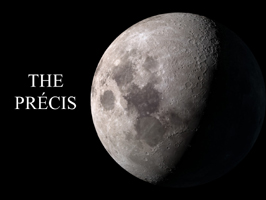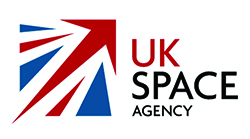 As part of the new partnership between SpaceWatch Middle East and The Précis, we will occasionally be publishing selected articles from the publication. The Précis is a quarterly space law and policy report produced by Space Law & Policy Solutions, run by the prominent space lawyer and friend of SpaceWatch Middle East, Michael J. Listner. Reproduced here are Dr. Christopher Newman’s views on UK Domestic Space Law in published in The Précis on March 31, 2017. Dr. Newman is a Reader in Law and Head of Postgraduate Research at the University of Sunderland in the UK and has been active in teaching and researching Space Law for a number of years.
As part of the new partnership between SpaceWatch Middle East and The Précis, we will occasionally be publishing selected articles from the publication. The Précis is a quarterly space law and policy report produced by Space Law & Policy Solutions, run by the prominent space lawyer and friend of SpaceWatch Middle East, Michael J. Listner. Reproduced here are Dr. Christopher Newman’s views on UK Domestic Space Law in published in The Précis on March 31, 2017. Dr. Newman is a Reader in Law and Head of Postgraduate Research at the University of Sunderland in the UK and has been active in teaching and researching Space Law for a number of years.
Details of how to subscribe to The Précis are provided at the end of this commentary.
Introduction
It has long been accepted the UK regulatory approach to Outer Space needs updating and that the nascent UK space industry has been stifled by a burdensome licensing procedure. In what appears to be a significant shift in legislative approach, the UK Draft Spaceflight Bill[1] seeks to capitalise on potential changes to the space sector and, according to Lord Ahmed (Minister for Aviation) make ‘the UK…the best place in Europe for space flight operations.’ With the British political landscape currently dominated by constitutionalism and the departure from the European Union, the decision of the UK Space Agency[2] to announce the Draft Spaceflight Bill at the recent Launch UK event[3] should be viewed as a welcome attempt to shift the focus away from Brexit and on to an area which is a crucial part of the developing UK industrial strategy[4]. Looking beyond this optimism, however, several questions exist in respect of the lack of substance within the Bill. Whilst some ambiguity is inevitable, the viability of the new structure hinges on an articulation of the granular detail. This discussion will outline the key elements of the Bill and highlight the areas of ambiguity that will need to be addressed before a true assessment of the new regulatory framework can be made.
Summary of the UK Draft Spaceflight Bill
 The UK Space Agency clearly views the space launch market as being a lucrative area, able to facilitate dramatic growth in the nascent UK space manufacturing and operations sector. The UK has established expertise in the development and construction of small satellites but it lacks independent launch capacity. Clearly, there are already several global launch providers who can provide rocket launches from much more appropriate geographical locations. The northerly position of the UK in respect of the equator, and the density of the population means that any proposed rocket launch site based in the UK starts with inherent disadvantages. The development of the Skylon single-stage-to-orbit space plane[5] based around the SABRE hybrid engine[6] has emboldened UK legislators to establish the legislative framework for the establishment of UK spaceports. These spaceports will allow horizontal flights to the edge of space and allow researchers to conduct ‘vital medical experiments’ in zero gravity. The stated aim of the Bill is to enable safe and cost-effective access to space. At the aforementioned Launch UK event, government ministers declared the intention to have a commercial spaceflight from a UK spaceport by 2020. The Bill, therefore, aims to put in place a framework dealing with the establishment of range control (ss.4-6), a licensing (ss.7-13) and regulatory scheme (s.14 and ss.24-29), a regime of consent and safety for spaceflight participants (ss.15-19). Administrative matters such as liability and insurance are covered in ss.30-34 and the rest of the Bill covers matters such as security matters (ss.20-24) and criminality (ss.48-54).
The UK Space Agency clearly views the space launch market as being a lucrative area, able to facilitate dramatic growth in the nascent UK space manufacturing and operations sector. The UK has established expertise in the development and construction of small satellites but it lacks independent launch capacity. Clearly, there are already several global launch providers who can provide rocket launches from much more appropriate geographical locations. The northerly position of the UK in respect of the equator, and the density of the population means that any proposed rocket launch site based in the UK starts with inherent disadvantages. The development of the Skylon single-stage-to-orbit space plane[5] based around the SABRE hybrid engine[6] has emboldened UK legislators to establish the legislative framework for the establishment of UK spaceports. These spaceports will allow horizontal flights to the edge of space and allow researchers to conduct ‘vital medical experiments’ in zero gravity. The stated aim of the Bill is to enable safe and cost-effective access to space. At the aforementioned Launch UK event, government ministers declared the intention to have a commercial spaceflight from a UK spaceport by 2020. The Bill, therefore, aims to put in place a framework dealing with the establishment of range control (ss.4-6), a licensing (ss.7-13) and regulatory scheme (s.14 and ss.24-29), a regime of consent and safety for spaceflight participants (ss.15-19). Administrative matters such as liability and insurance are covered in ss.30-34 and the rest of the Bill covers matters such as security matters (ss.20-24) and criminality (ss.48-54).
Reconfiguring the Air/Space Boundary
The first point of significance in the Bill is found in s.1(3) of the Bill. This provides that the activities covered with the Bill applies to ‘a rocket or other craft that is capable of operating above the stratosphere’ or ‘a balloon that is capable of reaching the stratosphere carrying crew or passengers’. This activity to be regulated, therefore, takes place above 50km (31 miles). This is unusual as most domestic space legislation tends to avoid committing to defining the limits of space. Clearly the intention on behalf of the drafters of the legislation is to indicate the areas where the new space activity will occur. Section 1(3) of the Bill provides the boundary where Aviation Law and the Law of Outer Space intersect is now significantly lower than the widely accepted ‘Karman Line’ of 100km. The classification of sub-orbital crafts and balloons as ‘spacecraft’ (under s.1(2) of the Bill) as opposed to aircraft provides further consolidation of this new boundary.
It is, however, worthwhile considering the different approach adopted within the New Zealand Draft ‘Outer Space and High Altitude Activities Bill’[7], which was intended by the NZ government to accomplish broadly the same goals at the draft UK Bill. The NZ Bill, however, deals with the Air-Space boundary by defining a high-altitude craft as being one which flies above ‘controlled airspace’. The distinction may be of little practical significance in the immediate future. In the longer term, however, it could have ramifications for activity in UK skies that occurs above 50km. Hypersonic flight has already seen an aircraft fly to well above the stratosphere[8]. Under the boundary set by the UK Draft Bill, such a craft may not be subject to rules regarding the sovereignty of airspace. This has clear military and strategic implications. Whilst the UK Bill is clear that this boundary only applies to licensed activities, it is submitted that this provision opens the door to unnecessary ambiguity.
Informed Consent and UK ‘Spaceflight’
 The choice of the stratosphere as the boundary for the new licencing regime is clearly linked to desire of the UK to become home to the nascent ‘near space’ tourism market. The embryonic – and by implication experimental – nature of space tourism ventures means, however, that issues such as passenger safety and the issue of consent will play a crucial part in any regulatory framework. The notion of passenger consent in respect of space tourism has long been a subject of debate within space law circles[9], the Draft Bill deals directly with this in s.15 by introducing the concept of ‘informed consent’ for individuals participating in spaceflight activities. S.15(1) states that the holder of an operator licence must not allow an individual to take part, in a prescribed role or capacity, in spaceflight activities carried out by the licensee unless the individual (a) has signified his or her consent to accept the risks involved in those activities, and (b) fulfils prescribed criteria with respect to age and mental capacity. The Bill, however, is silent as to the crucial details as to what information the individual will be furnished with to inform the consent. Under s.15 (3) the Bill states that this will be dealt with under secondary legislation.
The choice of the stratosphere as the boundary for the new licencing regime is clearly linked to desire of the UK to become home to the nascent ‘near space’ tourism market. The embryonic – and by implication experimental – nature of space tourism ventures means, however, that issues such as passenger safety and the issue of consent will play a crucial part in any regulatory framework. The notion of passenger consent in respect of space tourism has long been a subject of debate within space law circles[9], the Draft Bill deals directly with this in s.15 by introducing the concept of ‘informed consent’ for individuals participating in spaceflight activities. S.15(1) states that the holder of an operator licence must not allow an individual to take part, in a prescribed role or capacity, in spaceflight activities carried out by the licensee unless the individual (a) has signified his or her consent to accept the risks involved in those activities, and (b) fulfils prescribed criteria with respect to age and mental capacity. The Bill, however, is silent as to the crucial details as to what information the individual will be furnished with to inform the consent. Under s.15 (3) the Bill states that this will be dealt with under secondary legislation.
There are several issues associated with the notion of informed consent that the Draft Bill simply sidesteps by means of s15(3). It is not clear how ‘informed’ the consent will be. There are, at this stage no statutory safeguards for the ‘enthusiastic layperson’ who may not either full appreciate the extent of the risk associated with spaceflight or be susceptible to companies praying on their understandable enthusiasm. The amount of information to be provided to an individual clearly must be fathomable to the reasonable person, although this caveat is not included within the terms of s.15 of the Bill. While the notion, therefore, is one that is recognisable, the true contours of informed consent are, as yet, unclear and there is no certainty as to the protection that will be afforded to the enthusiastic layperson – who will surely be the vanguard of the new era of space tourists.
Changing nature of regulation
With both launches of satellites and humans being actively solicited, the role of the regulatory bodies is going to be of fundamental importance. At present, under the Outer Space Act 1986, the UK Space Agency serves as the regulator and licensing agency for space activity within the UK. The Bill dramatically reforms this bring in a joint approach to regulation involving the UK Space Agency, the Civil Aviation Authority (CAA – responsible for overseeing and regulating all civil aviation in the UK) and the Health and Safety Executive (HSE – responsible for regulating health and safety in the workplace). The duties of the regulator are detailed in s.2 of the Bill, the appointment of the regulator is dealt with under s.14 of the Bill and the responsibilities of the regulator in respect of monitoring and enforcement can be found under s.24 of the Bill.
Whilst the Launch UK event provides some details as to how this joint regulatory framework will operate[10], clearly there are areas of overlap. The very nature of horizontal powered and balloon flights to the end of the stratosphere means that there will need to be a significant amount of input from the CAA, whilst HSE would appear to have responsibility for the safety of the spaceports themselves. The overlap between these and the existing regulation of OSA activities by the UK Space Agency provides another illustration of the sketchbook nature of the Draft Bill. Clearly, relations between these diverse regulatory bodies is currently both cordial and constructive, with all agencies committed to developing a regulatory framework that supports UK space activity. Nonetheless, there is clearly work that needs doing on a practical level to establish operating procedures, lines of responsibility and protocols for managing disputes in jurisdiction.
Reassessing the role of Outer Space Act 1986
The lack of specificity in respect of the regulatory protocols also links in to a broader sense of confusion regarding the status of the current legal requirements as articulated within the Outer Space Act (OSA) 1986[11]. It is quite clear from reading the Bill that this new regulation is intended to run in parallel with the existing OSA regime. Schedule 10, para 4 of the Bill provides for an amended s1(2) of the 1986 Act which states that the OSA does not apply to activities carried on in the United Kingdom (and accordingly does not apply to activities requiring authorisation under section 3(1) of the Spaceflight Act 2017). Space activity – such as the procurement and launch of small satellites within the UK – is clearly intended to come within the ambit of the Draft Bill. Yet, given the broad dissatisfaction with the OSA regulatory framework, it is surprising that the UK government did not grasp the opportunity to conduct an overarching reform of the regulation of all space activity within the UK.
It is also striking that the Bill makes very little explicit mention of several key issues that preoccupy those within the international space law community. There are numerous mentions within the Bill of the need to consider ‘the international obligations of the United Kingdom’, yet the Bill appears to be very inward looking. There is no explicit mention of the Outer Space Treaty and there is no attempt, as there was with the US Space Resource Exploration and Utilization Act, to become involved with celestial mining. As much of the UK Bill appears to be little more than a placeholder, with key elements yet to be fleshed out, the reason for this omission is slightly puzzling.
Perhaps even more concerning is the lack of bespoke provision within the Bill to guard against further degradation to the delicate space environment. It is suggested that the development of a new framework afforded the UK Government the opportunity to take moral, if not strategic, leadership on the issue of environmental protection. S.2(2)(e) of the Bill states that the powers and duties of the regulator must take into account any environmental objectives set out by the Secretary of State. Also, Schedule 1, Para 13 allows for licence conditions which ‘prevent the contamination of outer space or adverse changes in the environment of the earth.’ It is submitted, however, that these provisions do not embed a concern for the delicate space environment, nor do they reflect the ever-growing threat to the continued use of space posed by human-created orbital debris. For a Bill that is seeking to generate wealth from exploiting the space environment, this is perhaps the most egregious of all the oversights in the Draft Bill.
Conclusion
 The claims made by the UK government of a new age of regulation, based on the Draft Spaceflight Bill, are somewhat optimistic. The Bill covers key areas only in outline and there is much within the Bill that needs to be augmented by secondary legislation. Additionally, there is little in the way of environmental protection and nothing in respect of celestial mining and resource allocation. The UK Space Agency have stated that the Bill is open for consultation, so clearly this is not the finished iteration of the new regulatory regime and remains skeletal rather than the definitive model. Instead of establishing a certain and robust regulatory framework, what the Bill represents is the start of the conversation, but with key definitional elements yet to be decided.
The claims made by the UK government of a new age of regulation, based on the Draft Spaceflight Bill, are somewhat optimistic. The Bill covers key areas only in outline and there is much within the Bill that needs to be augmented by secondary legislation. Additionally, there is little in the way of environmental protection and nothing in respect of celestial mining and resource allocation. The UK Space Agency have stated that the Bill is open for consultation, so clearly this is not the finished iteration of the new regulatory regime and remains skeletal rather than the definitive model. Instead of establishing a certain and robust regulatory framework, what the Bill represents is the start of the conversation, but with key definitional elements yet to be decided.
Rather than looking at the omissions, however, it is more instructive to acknowledge the existence of any government recognition of the importance of the space industry. At first sight, the Draft Spaceflight Bill does at least start to address much that has previously been missing from UK space regulation. The small satellite industry in the UK has previously been stifled by the ‘one-size-fits-all’ approach of the Outer Space Act 1986 licensing regime. Perhaps, the mere existence of the Bill is a triumph for space advocates within the UK, and the space community can now engage with legislators to shape this new era of regulation.
[1]https://www.gov.uk/government/uploads/system/uploads/attachment_data/file/592928/draft-space-flight-bill-web.pdf[2] The branch of the civil service charged with overseeing UK civilian space strategy.
[3]https://www.gov.uk/government/news/launch-uk-brings-together-uk-commercial-space-sector
[4] For details of the on-going consultation regarding the UK Industrial Strategy see https://www.gov.uk/government/consultations/building-our-industrial-strategy
[5] http://www.space.com/32112-how-skylon-space-plane-works-infographic.html
[6] https://www.reactionengines.co.uk/
[7] http://www.legislation.govt.nz/bill/government/2016/0179/latest/DLM6966275.html
[8] See, for example the X-15 program which saw the aircraft reach altitudes of 354,200 feet https://www.nasa.gov/centers/armstrong/news/FactSheets/FS-052-DFRC.html
[9] See inter alia Stephan Hobe, ‘Legal Aspects of Space Tourism’, (2007-2008) 86 Nebraska Law Review pp. 439-458 and, specifically in respect of informed consent see Tracey Knutson ‘What is ‘Informed Consent’ for Space-Flight Participants in the Soon-To-Launch Space Tourism Industry’ (2007) 33 Journal of Space Law pp105-118
[10]https://www.gov.uk/government/uploads/system/uploads/attachment_data/file/597320/Launch_UK.pd
[11] http://www.legislation.gov.uk/ukpga/1986/38/contents
Dr. Christopher J. Newman is a Reader in Law and Head of Postgraduate Research at the University of Sunderland in the UK and has been active in teaching and researching Space Law for a number of years. Dr. Newman has published numerous scholarly articles and worked with academics across various disciplines on issues of Space Governance. Opinions are his own and do not reflect the views or opinions of the University of Sunderland.
Disclaimer
The Précis is a product of Space Law & Policy Solutions. Opinion, commentary and analysis contained in The Précis is for informational purposes. The Précis is not legal advice nor is it a substitute for legal advice. Subscription to The Précis does not create an attorney/client relationship nor is information contained within protected by attorney/client privilege. The Précis may not be reproduced, distributed, or transmitted in any form or by any means, including but not limited to photocopying, edits, website uploads or other electronic or mechanical methods, except for quotations with proper citation, without the express permission of the author.
SpaceWatch Middle East thanks Michael J. Listner for permission to republish his work.
To subscribe to The Précis please visit: http://www.spacelawsolutions.com/the-pr-cis-.html
Republished at: https://spacewatch.global/2017/04/the-precis-uk-domestic-space-law/
 SpaceWatch.Global An independent perspective on space
SpaceWatch.Global An independent perspective on space

